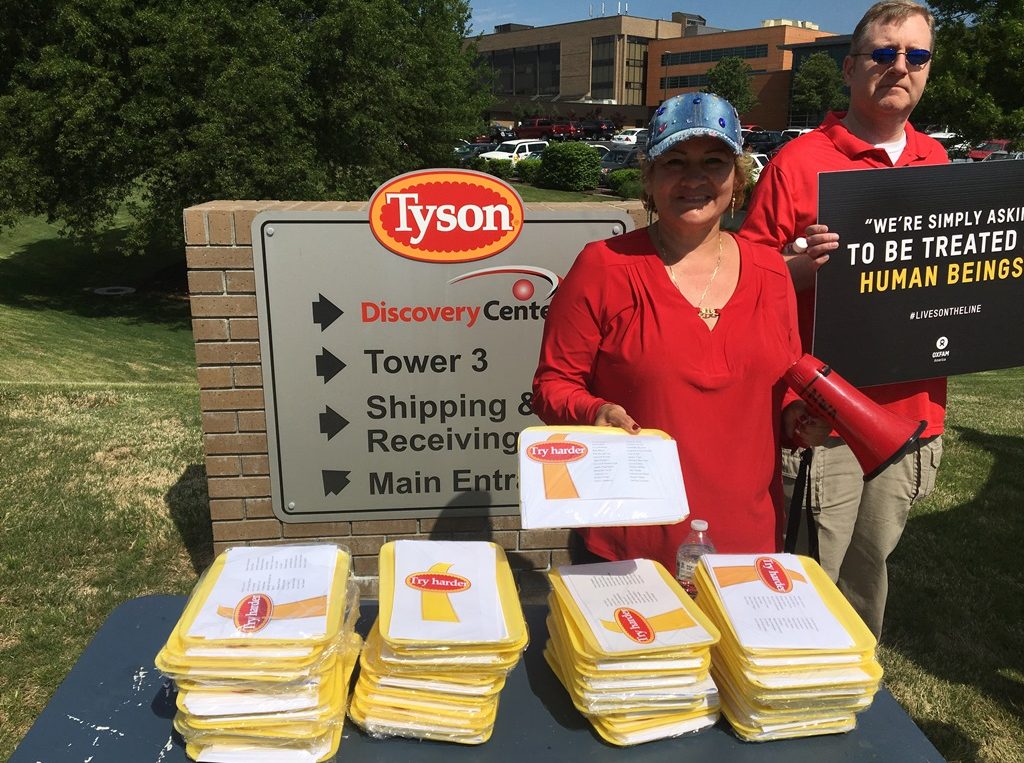Sunshine is the best disinfectant: Exposing conditions in the poultry industry is leading to change
 In May, dozens of workers and advocates rallied outside Tyson headquarters in Springdale, AR to join Oxfam in delivering petitions from over 150,000 consumers to the company. Rosa, above, who worked at a Tyson plant in Arkansas until she was injured, notes, “They want submissive employees… For them, a happy employee is a quiet one.” Mary Babic/Oxfam America
In May, dozens of workers and advocates rallied outside Tyson headquarters in Springdale, AR to join Oxfam in delivering petitions from over 150,000 consumers to the company. Rosa, above, who worked at a Tyson plant in Arkansas until she was injured, notes, “They want submissive employees… For them, a happy employee is a quiet one.” Mary Babic/Oxfam America
When Oxfam published its landmark report on working conditions in the poultry industry last fall, we noted that “It’s time for industry, the government, and consumers to take action for vital changes.”
As the grim reality of life inside the plants has been gradually exposed, people have been pushing for change. Today, we are seeing some real progress, thanks to actions on all fronts.
It really is hard to believe what happens inside poultry plants in the US: dangerous working conditions, low pay with few benefits, and workers toiling in a climate of fear. And it’s harder to believe that poultry companies are willing to treat workers with such fundamental lack of respect or care for their health and safety. It raises a lot of questions: “How do the companies get away with this? Why doesn’t the government do something? Is this legal?”
The answers, like the industry, are complicated, rooted in the economic and social history of our country. Before Oxfam launched our report, Lives on the Line, last fall, we talked to a lot of people who know the industry well: workers, advocates, attorneys, medical experts, and more. What we heard was shocking – and often illegal. As we rolled out our campaign, we hoped that shining light inside the plants would prompt action.
And the good news is — we’re seeing movement.
The movement
Over the last few years, various organizations have been shining a very bright light on the workers. Several scathing reports exposed horrors inside the plants: Oxfam, Southern Poverty Law Center, Northwest Arkansas Workers’ Justice Center, and Greater Minnesota Worker Center. Oxfam is partnering closely with organizations that have been working on the issue for years; that coalition was central to the effort in 2014 to prevent an increase in the maximum line speed.
The Oxfam campaign has used a variety of angles to pressure the industry. More than 150,000 consumers have signed a petition to the top four companies (Tyson Foods, Pilgrim’s, Perdue, and Sanderson Farms); we delivered the petitions to Tyson headquarters in May. We filed shareholder resolutions with Tyson Foods and Sanderson Farms, and attended their annual meetings. We’ve been in direct contact with management at all four companies. In May, our report on the denial of bathroom breaks sparked a storm of interest in media and on social media.

The government response
At the same time, the coalition has been pushing the federal government to take a greater role in oversight of the industry.
In May, the Government Accountability Office (GAO) released a report on conditions in the meat and poultry industry. Following up on their report in 2005, government investigators confirmed what many have been reporting for years: poultry workers continue to face multiple hazards that put them at great risk.
Last fall, OSHA announced two new Regional Emphasis Programs (and has subsequently added a third), to provide greater oversight and enforcement of health and safety standards in the poultry industry. OSHA noted that “Poultry workers are twice as likely to suffer serious injuries and six times more likely to get sick on the job than other private sector workers.”
Those programs mean the agency is ready to investigate when problems surface. Recently, OSHA issued shocking findings from two inspections.
Earlier this month, OSHA announced results from an investigation into a Pilgrim’s plant in Florida, including 14 “serious” citations. For the first time, OSHA found evidence of “medical mismanagement,” as workers “in pain, ill, or injured” were not referred to a doctor when necessary.
Last week, OSHA released findings from an investigation into a Tyson plant in Texas where a serious amputation occurred. OSHA says: “A gruesome employee injury led federal workplace safety inspectors to discover the nation’s largest meat and poultry processor endangered workers by exposing them to amputation hazards, high levels of carbon dioxide and peracetic acid without providing personal protective equipment.”
OSHA found 15 different “serious violations,” two repeat violations, and issued fines of $263,498. While a small amount for a company of Tyson’s size (it’s the number one chicken producer in the country, with over $40 billion in annual revenue), OSHA was quite emphatic in making the company responsible for workers’ safety and health. “Tyson Foods must do much more to prevent disfiguring injuries like this one from happening,” said Dr. David Michaels, assistant secretary of labor for Occupational Safety and Health.
More needs to be done
Oxfam and our partners have been encouraging OSHA to take a more proactive role in investigating the poultry industry; it’s heartening to see increased enforcement.
Still, the main targets of the campaign, the top four poultry producers in the country, have yet to make the significant changes needed. While Tyson has strong, publicly stated policies about working conditions in its “Team Member Bill of Rights,” the reality inside plants is actually quite different. Often, proper precautions are simple and inexpensive, and vital to safeguard workers. Oliver Gottfried, senior campaign strategist at Oxfam, notes, “Tyson needs to be accountable to workers and consumers about how people are treated, and deliver on its promises of transparency and accountability.”
The need for action
It’s taken a lot of effort by a lot of people to expose the grim reality inside poultry plants, and to push the industry to change. There’s a long way to go, but, we’re seeing signs of progress.
We encourage you, as a consumer, to wield your power in exposing the problem and demanding changes.